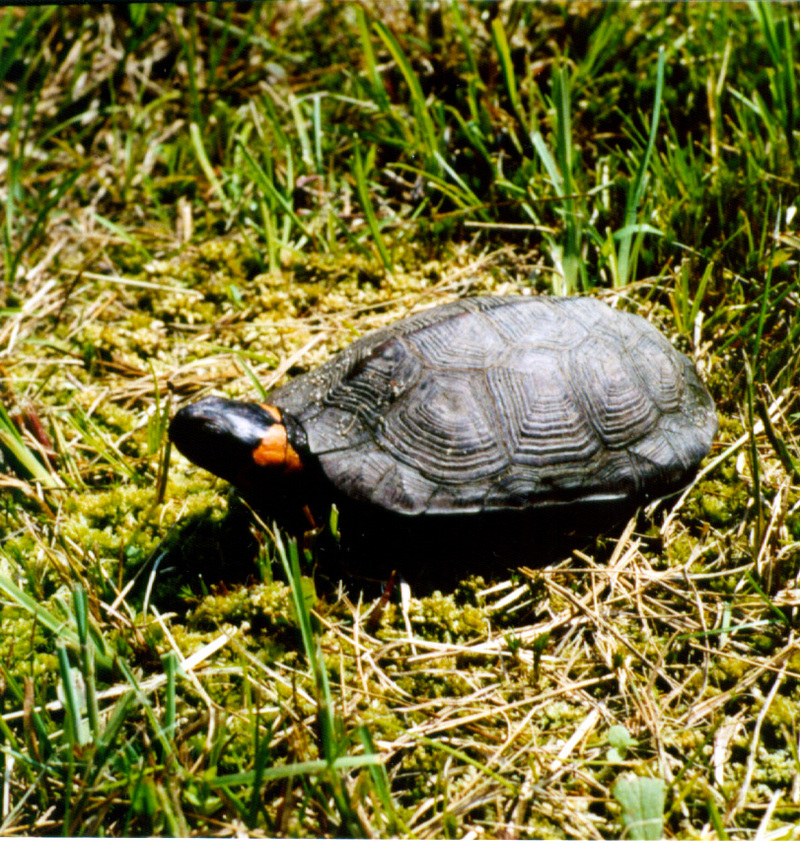Bog turtle (Clemmys muhlenbergii) Bog turtle
From Wikipedia, the free encyclopedia
[Photo] Bog Turtle (Clemmys muhlenbergi). Source: US Army Corps of Engineers - http://www.sas.usace.army.mil/rbogtrtl.htm
The Bog Turtle (Clemmys muhlenbergii) is a turtle native to the Eastern United States. It is one of the smallest species of turtle and is considered threatened at the federal level and endangered in some states.
Physical Attributes
Weight: Approximately 4 ounces.
Length: 3???4.5 inches.
Identification: A bright yellow or orange blotch on each side of its head and neck are a distinctive feature of this species. The body color is dark with an orange-red wash on the inside of the legs of some individuals. The carapace is domed and somewhat rectangular, often with prominent rings on the scutes. In some older individuals, or those that burrow frequently in coarse substrates, the shell may become quite smooth and polished. Although generally black, the carapace is sometimes highlighted by a chestnut sunburst pattern in each scute. The plastron is hingeless, with a pattern of cream and black blotches. As with most turtles, the plastron of the male is slightly concave while the female's is flat.
Habitat
Calcareous (containing calcium carbonate, calcium or lime) wetlands such as open sphagnum bogs, wet meadows and wet pastures. Bog turtles currently occur in scattered colonies in western Connecticut, western Massachusetts, and through New York, south to northeast Maryland, southern Virginia, western North Carolina, the upstate of South Carolina and Georgia. Bog turtles rely on an abundance of grassy or mossy cover and high humidity. Open, sunny areas where the turtles can bask to raise their body temperature are also important. While hibernating (from the winter months until March or April) bog turtles hibernate underwater in deep areas of bogs in about 6 to 18 inches of mud. Immature turtles do not hibernate in deep mud until they are 2 to 3 years old.
Food and Feeding
The turtles feed during the daylight hours; however, they are seldom active during the hottest part of the day. Their food sources include seeds, berries, insects, slugs, worms, crayfish, frogs, snakes, snails and carrion.
Reproduction and Life Span
Bog turtles breed in late April to early June after emerging from hibernation. Nests are usually in tussocks or on sphagnum moss in sunny areas of a bog. Mating occurs for the most part in spring and the resulting eggs (2-5) are laid from June to July in a nest which is generally located inside the upper part of an unshaded tussock and are left on their own to develop and hatch. Incubation lasts for 7 to 8 weeks and hatching occurs from July to early September. In colder climates, eggs may overwinter in the nest and hatch in the spring when there is an abundant food supply. The nests are often preyed on by skunks and raccoons. The young are only 1 inch long at hatching and are often taken by a variety of birds and mammals.
Bog turtles reach sexual maturity at 5 to 8 years of age.
Although specifically unknown, the maximum age is estimated to be between 30 and 40 years, though many turtles do not reach this point due to the fact that they fall prey to raccoons, skunks, foxes and dogs.
Threats and Environmental Notes
Intensive development pressure in all portions of the bog turtle's range have caused the draining and filling of many wetlands. Remaining wetlands have been isolated, resulting in the fragmentation of bog turtle populations. These small populations cannot mix with others and only breed within themselves. The result is a loss of genetic variation, which then reduces the population's ability to adapt to a changing environment. Bog turtles are very sensitive to changes in their environment, such as increased nutrification, altered drainage, vegetation changes or pollution.
Collection for the pet trade has further depleted local populations. In 1973, the bog turtle was given protection by CITES, the Convention on International Trade in Endangered Species, and it is currently a candidate to be put on the federal endangered species list. In certain states it is against the law to remove any bog turtle, including eggs, from the wild. Bog turtles may not be collected from the wild, and they should not be kept as pets.
